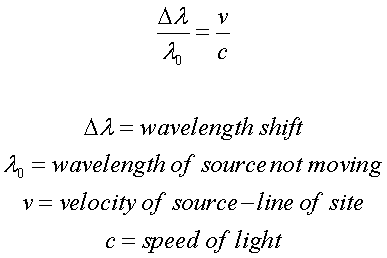

For waves propagating in vacuum, such as electromagnetic waves or gravitational waves, only the difference in velocity between the observer and the source needs to be considered. The total Doppler effect may therefore result from motion of the source, motion of the observer, motion of the medium, or any combination thereof. The distance between successive wave fronts is then increased, so the waves "spread out".įor waves that propagate in a medium, such as sound waves, the velocity of the observer and of the source are relative to the medium in which the waves are transmitted. Conversely, if the source of waves is moving away from the observer, each wave is emitted from a position farther from the observer than the previous wave, so the arrival time between successive waves is increased, reducing the frequency. While they are traveling, the distance between successive wave fronts is reduced, so the waves "bunch together". Hence, the time between the arrivals of successive wave crests at the observer is reduced, causing an increase in the frequency.

Therefore, each wave takes slightly less time to reach the observer than the previous wave. The reason for the Doppler effect is that when the source of the waves is moving towards the observer, each successive wave crest is emitted from a position closer to the observer than the crest of the previous wave. Compared to the emitted frequency, the received frequency is higher during the approach, identical at the instant of passing by, and lower during the recession. It is named after the Austrian physicist Christian Doppler, who described the phenomenon in 1842.Ī common example of Doppler shift is the change of pitch heard when a vehicle sounding a horn approaches and recedes from an observer. Named after Austrian physicist, Christian Andreas Doppler (1803-1853) 1.The Doppler effect or Doppler shift (or simply Doppler, when in context) is the apparent change in frequency of a wave in relation to an observer moving relative to the wave source. the Greek letter theta (θ) is also used.Q is the angle between ultrasound beam and axis of flow.c is the velocity of sound in the medium.f o is transmitted frequency from ultrasound probe.This is accounted for in the Doppler equation with the "cosine(θ)" parameter the maximum Doppler shift occurs when the relative motion occurs at a Doppler angle of 0 degrees (the cosine of 0 = 1) and no Doppler shift will be noted when the motion of the reflecting source is perpendicular (cosine of 90 = 0) 3. The magnitude of the Doppler shift is also affected by the angle at which the reflecting source is traveling in relation to the transmitting source. spectral envelope (in continuous and pulsed wave Doppler) below the baseline.source reflecting sound waves is moving away from the emitting source.frequency of received sound waves spectral envelope (in continuous and pulsed wave Doppler) above the baseline.source reflecting sound waves is moving toward the emitting source.frequency of received sound waves > frequency of emitted sound waves.an ultrasound transducer) the frequency of the sound waves received will be higher (positive Doppler shift) or lower (negative Doppler shift) than the frequency at which they were emitted, respectively 2. However, if the reflecting source is in motion either toward or away from the emitting source (e.g.

When sound of a given frequency is discharged and subsequently reflected from a source that is not in motion, the frequency of the returning sound waves will equal the frequency at which they were emitted. Doppler shift or Doppler effect is defined as the change in frequency of sound wave due to a reflector moving towards or away from an object, which in the case of ultrasound is the transducer.


 0 kommentar(er)
0 kommentar(er)
